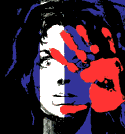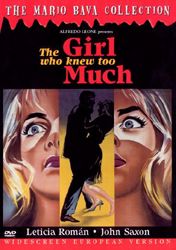
|
THE GIRL WHO KNEW TOO MUCH REVIEW BY GARY JOHNSON
Leticia Roman stars as an American named Nora Davis who is vacationing in Rome. She habitually reads mystery novels but has agreed to her mother's demand and will stop reading mysteries (after she finishes the one she's currently reading, anyway). She will stay with an elderly friend of the family. However, late one evening, the friend dies before her eyes. Horrified, Nora stumbles onto the streets of Rome, where she is soon mugged and knocked unconscious. She wakes in a haze and witnesses a murder before drifting unconscious again. She tries to tell everyone about the murder, but no one believes her. The doctor who treats her says she is suffering from "mythomania"--a consequence of a blow on the head. Nora decides to investigate the murder on her own and discovers a series of murders was committed ten years ago--the "Alphabet Murders." The victims were chosen in alphabetical order (e.g., Abbart, Beccati, and Craven). Nora's last name, Davis, suggests she may be next in line.
Overall, The Girl Who Knew Too Much is much preferable to The Evil Eye. Several of the changes in The Evil Eye only serve to confuse matters. For example, in The Evil Eye, we don't see the face of the man who pulls the knife out of the back of a murdered woman--but recognizing his face becomes important later when the camera gives us a close-up of a framed portrait on a piano: it's the same man! When we see the portrait in The Girl Who Knew Too Much, we instantly understand that Nora has stumbled into a very dangerous situation; however, in The Evil Eye, we can't make this connection and thus the movie is robbed of a crucial element of suspense. Because The Evil Eye contains several minutes of footage not found in The Girl Who Knew Too Much, this DVD ideally would have included both versions of the movie. For example, the final sequences from both movies are completely different. But it's hard to argue about this DVD considering the excellent quality of the video transfer. The Girl Who Knew Too Much looks marvelous. This is one of Bava's best movies and it contains several astonishing images, such as an overhead view of Nora as she lies on a hospital bed. At first, we just see bobbing shapes, like balloons, and it's difficult to identify what Bava's camera is capturing. Then as the shapes part and we see Nora, we realize the shapes are habits upon the heads of several nuns/nurses. Bava photographs Leticia Roman with great care. He casts ominous shadows across her face, yet she remain sensuous and evocative. John Saxon as her love interest looks somewhat lost, but that's by design. As he begins to fall in love with Nora, she hardly gives him any attention. She's totally absorbed in investigating the murder. Image Entertainment's DVD presentation of The Girl Who Knew Too Much contains the Italian language version with optional English subtitles. The movie is presented in its original aspect ratio of 1.66:1.
The Girl Who Knew Too Much is now available on DVD from Image Entertainment in its original aspect ratio of 1.66:1. The DVD has been enhanced for 16X9 televisions. Special features: Mario Bava biography by Tim Lucas of Video Watchdog; director and cast filmographies; theatrical trailer; and a photo and poster gallery. Suggested retail price: $24.99. For additional information, we suggest you check out the Image Entertainment Web site.
|
 Mario Bava's reputation largely rests on his horror films, but he also directed movies in several other genres, including Westerns, sword-and-sandal fantasies, James Bond-ish adventures, and even a Viking tale. He's also known for directing the seminal "giallo" thriller The Girl Who Knew Too Much. Named after a variety of Italian pulp novels printed on yellow paper ("giallo" means yellow in Italian), these thrillers frequently feature a hero or heroine who investigates a crime and finds himself/herself embroiled in a dangerous situation. Dario Argento's The Bird With Crystal Plumage and Deep Red are two of the most notable examples of this genre. But in 1963, Bava was treading in new territory when he created The Girl Who Knew Too Much. The American retitling--The Evil Eye--served to obscure the movie's rather obvious debt to Alfred Hitchcock's tale of foreigners abroad (i.e., The Man Who Knew Too Much).
Mario Bava's reputation largely rests on his horror films, but he also directed movies in several other genres, including Westerns, sword-and-sandal fantasies, James Bond-ish adventures, and even a Viking tale. He's also known for directing the seminal "giallo" thriller The Girl Who Knew Too Much. Named after a variety of Italian pulp novels printed on yellow paper ("giallo" means yellow in Italian), these thrillers frequently feature a hero or heroine who investigates a crime and finds himself/herself embroiled in a dangerous situation. Dario Argento's The Bird With Crystal Plumage and Deep Red are two of the most notable examples of this genre. But in 1963, Bava was treading in new territory when he created The Girl Who Knew Too Much. The American retitling--The Evil Eye--served to obscure the movie's rather obvious debt to Alfred Hitchcock's tale of foreigners abroad (i.e., The Man Who Knew Too Much).

